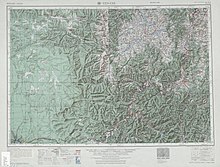Tienchih
Jump to navigation
Jump to search
English
[edit]
Etymology
[edit]From Mandarin 天池 (Tiānchí), Wade–Giles romanization: Tʻien¹-chʻih².
Proper noun
[edit]Tienchih
- Alternative form of Tianchi
- 1961, Rewi Alley, China's Hinterland in the Leap Forward[1], →OCLC, page 498:
- Changpaishan, with its snow-capped peak, an old crater in which the lake called Tienchih lies, still has its place in the imagination of the people.
- 1975 December, Jen Chung, “Visit to a Natural Preserve”, in China Reconstructs[3], volume XXIV, number 12, Peking: China Welfare Institute, →ISSN, →OCLC, page 44, column 1:
- The main peak of the Changpai Mountains is a volcano which last erupted in 1702. Lava piled up around the crater and formed a huge cone which through the years became filled with water and is now known as Tienchih Lake (Heavenly Lake). This slightly oblong lake, which measures four kilometers from north to south, and three from east to west is surrounded by 16 peaks whose reflection in the blue water on a clear day forms a spectacular sight.
- For more quotations using this term, see Citations:Tienchih.